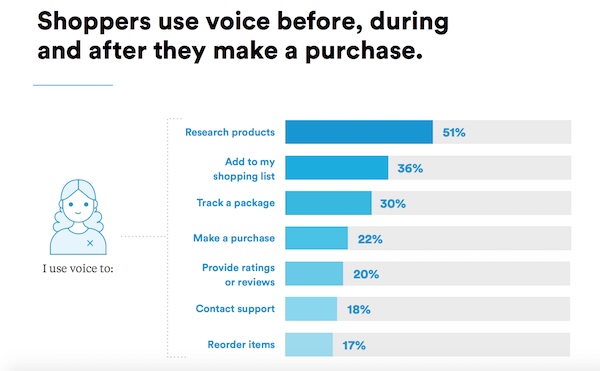Theodore Twombly’s attachment with his AI-assistant ‘Samantha’ in the movie HER might have seemed like an outlandish concept, but today with Siri, Alexa and Google Now, becoming smarter and more human, consumers’ relationship with assistants is changing.
In a digitally connected world, people are craving for more human connections, digital assistants are somewhere filling that gap. In a recent survey, 41 percent of consumers said using a digital assistant makes them feel that they are talking to a friend. While consumers are slowly getting comfortable with voice assistants, does that mean that they are ready to use them to shop?
Let’s see how consumers are using voice assistants when it comes to shopping-
Voice assistants are picking up, but aren’t there yet
A recent report by Comscore suggests, only 11% of consumers are using voice assistants for ordering products and 8% for ordering food and services. The above statistics implies that even though the voice assistants are garnering consumers’ interest, the technology hasn’t advanced yet to gain consumers trust to make final purchases.
Voice assistants are used for optimising the purchase process, but not final purchase
Even when people are using voice assistants during the purchase process, they don’t use it to make the final purchase. The use of voice assistants while making a purchase varies from researching about the product to reordering items.

Why are consumers reluctant to shop via voice assistants?
Some of the reasons for this reluctance of consumers in using voice assistants to make a purchase are-
– The medium is not simple enough yet.
Online shoppers are used to completing the entire purchase journey from researching the product to making the payments, on one medium. However, this process hasn’t been simplified for the voice assistant technology yet.
– There isn’t enough personalization.
When it comes to smartphones or the web shoppers are used to an extremely personalized experience, with the retargeting ads, recommendations etc. However, that isn’t the case with voice assistants yet. To shop through the voice assistants, consumers will need to give very specific instructions, which makes the experience complicated. A lot of times consumers aren’t even sure of the brand or even the product category they want to buy. Shopping through voice assistants is easier for smaller day-to-day products like groceries etc. However, where consumers need some helping hand in making a decision – like buying a gift item, voice assistants have still a long way to go.
– The technology is still evolving.
Even with smartphones being such an integral part of the consumers’ life, they are still not shopping on it. Only 27 percent of shoppers make a purchase on their devices.
When it comes to voice assistants the reluctance to adapt to the technology is more to do with the consumer’s habit of researching, comparing prices, reading reviews etc. which isn’t as seamless on voice assistants yet. Of course, it’s possible to add shopping items to your list via voice but it works for items that you commonly use and ones that don’t need research or reviews from other users. The technology as such will have to evolve to integrate the entire purchase cycle, as is the case with web or mobile commerce.
In conclusion:
Voice search is becoming popular amongst users, the interest is more to do with the novelty of the technology than it being able to add any significant value to the consumer’s life as yet, especially when it comes to making purchases. However, with the advancements in NLP (Natural Language Processing), AI, VR/AR, deep learning, etc. voice assistants will soon bridge the gap of what consumers expect from the technology. Hence, it will help retailers and the e-commerce industry to prepare for this change right now, when users are still becoming accustomed to the technology, interest levels are growing and the entry barriers are low.
This article is inspired by the detailed write-up on ‘voice assistants in retail’ on Robosoft Technologies blog.



